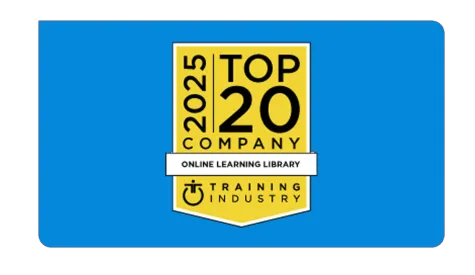4 Best Practices for Keeping an Organized eLearning Video Library

When I looked in my closet this past weekend, I was overwhelmed. I saw items I no longer wear. Am I really going to wear that bridesmaid's dress again? No, I’m not, but it has sentimental value. Will I ever wear that leopard print spandex top from our Glamour Shots shoot? If I do, it would be a joke. Then there are the items that no longer fit, but I thought maybe someday I could squeeze myself back into them so I saved a few for “motivation." Also, due to my unorganized chaos, I found items that I thought were lost and had replaced three or four times. What a waste of money and storage space! But it got me thinking... you need to keep these same ideas in mind as you build and organize your eLearning Library.
1. Determine what content you need and throw out what you don’t.
How many dresses, shirts, pants, and strange Halloween costume items do you have in your closet that you’re holding onto “just in case?” My guess, if you’re anything like me, it’s at least one too many and it’s time to clear out the clutter. This same idea works with your eLearning library too – keep only what you’re going to use now and discard the content that’s only taking up space. The best eLearning libraries provide content “just as needed."
Similar to how having too many “someday” dresses can make it difficult to find your everyday clothes, having too many videos can overload your employees. Instead of wasting time digging through titles, they’ll either select titles that don’t apply to them, or they won’t use the training at all. If you currently have a video library, run some usage reports and see what your employees are or are NOT watching. Match up your course titles with learning competencies and job responsibilities to determine what programs you can get rid of and what makes sense to keep.
This tailored curriculum, without any unnecessary courses, will help organize your video library in a way that pairs them with tasks and situations that employees deal with day-to-day.
2. Don’t fall for fads. Stick with industry-supported trends.
We’ve all been subjected to a number of quirky fashion fads over the years, such as parachute pants or bandana shirts, that, though we couldn’t see it then, were only popular for a moment in time and then their popularity (and appropriateness in public) faded.
The same thing happens in the eLearning industry as well – someone will create a new technology, such as virtual reality, and companies will quickly jump to join in on the new and exciting trend. Instead, you must remember that just like platform sneakers, the newest and most popular “trend” may not last. Once your training initiative is viewed as a fad or a flavor of the month, you lose credibility and your employees suffer.
One thing we do know is that, just like your little black dress, some things never go out of style. Videos must be created with sound instructional design to ensure that they’re “just right” for employees and will last for many years.
"Instructional Design is defined as a systematic process that is employed to develop education and training programs in a consistent and reliable fashion” (Reiser, Dempsey, 2007).
A few key factors that come into play when practicing quality instructional design include:
- Length of program: keeping videos in small, digestible chunks
- Learning styles of learners: considerations for visual, audio, and reading/writing learners
- Captivating content: engage rather than entertain
3. Choose a platform that’s easy to use and accessible.
So now that you’ve sorted through your closet, what are you going to use to keep it organized? There are several routes you can take from simple to elaborate. It needs to be something easy and cost effective. Yes, I would LOVE a custom-built closet but that’s not realistic for me. An assortment of bins, adjustable shelves and totes can help you find a “home” for every clothing item and accessory.
A learning management system, or LMS, has this same function. It can assure all your eLearning content, video courses, quizzes, reports, and reinforcement tools have their own “homes.” You can’t just throw everything in a bin and hope that you’ll remember where it is or that someone else would be able to find it. Memory depends on recognizable patterns and trying to alphabetize your clothes by brand name isn’t going to be as effective as if you sorted them by color and type.
You can achieve this same level of desired organization by offering an LMS that employees can navigate with ease, but also that managers can use to evaluate the engagement and effectiveness of its training courses. When you give managers and administrators the ability to organize employees in groups, assign tasks and courses, and record their own content, the LMS, or eLearning closet, becomes a perfectly coordinated resource rather than just a place where eLearning content lives.
In fact, the best learning management systems make content immediately accessible, “just in time” to be useful in such contexts. This includes:
- Storing content in the cloud (or on an accessible server) so that it can be accessed anytime, anywhere
- Making content available on both desktop and mobile devices
- Creating content that is short enough to be consumed throughout an employee’s workflow
4. Make these practices a routine.
You’re not done yet! Just because everything looks pristine now doesn’t mean it’s going to look like that when it’s time to pull out swimsuits and sundresses. Every season you must go back in and reevaluate what is needed, where to put things, and what you haven’t touched in the past few months. A friend once told me that an easy way to see what you’re wearing is to originally hang everything up with the hanger facing toward you. As you wear things, hang them back up with the hanger facing away from you. If there are items facing toward you when you go through again, it’s time to throw them out.
My point is, keeping your closet or your eLearning library organized and up-to-date is an ongoing initiative that requires attention, expertise, and review. As the industry continues to evolve, and the seasons change, so should your eLearning library. Make sure to stay aware of emerging trends and never get caught with last season’s leftovers, whether it be your wardrobe or your eLearning content.
Additional Resources
- Part of managing your training library involves keeping things fresh. Learn more in our blog "Fresh Content Matters, Here's Why."
- If you are searching for an eLearning video provider, one of the questions to ask is how fresh is their content? Our blog "How to Buy eLearning Content for Your LMS (And Not Regret It Later)" gives you a checklist of other questions to ask.
- It's important not to overwhelm your team with too much training to manage. Read more in our white paper "How Many Courses Do You Really Need?"


